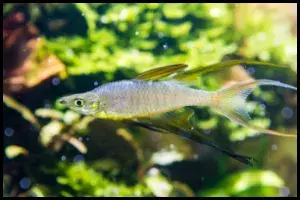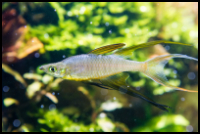


Quick Care Details (Table)
| Livestock Characteristics | Value |
|---|---|
| Care Level | Moderate |
| Temperament | Peaceful |
| Diet | Omnivore |
| Maximum Size | 2 Inches |
| Minimum Tank Size | 10 Gallons |
| Plant Safe | Yes |
| Temperature Range | 72-78F |
| PH Range | 6.0-7.5 |
| KH Range | 7-10 |
Species Specific Categories
Helpful Video
Care Details
Aquascape:
- Threadfin Rainbows and Rainbowfish thrive in heavily planted aquariums with plenty of hiding spots and swimming space.
- Opt for densely planted areas using fine-leaved plants like Java moss or Cabomba for the Threadfin Rainbows to explore and spawn.
- Utilize driftwood, rocks, and other decorations to create caves and crevices for the Rainbowfish to retreat into.
Substrate:
- A fine-grained substrate like sand or smooth gravel is preferable to mimic their natural habitat.
- Ensure the substrate is well-rinsed before adding it to the aquarium to prevent cloudiness.
Disease Prevention:
- Maintain excellent water quality through regular water changes and proper filtration.
- Quarantine new fish before introducing them to the main aquarium to prevent the spread of diseases.
Filtration:
- Use a reliable aquarium filter rated for the size of your tank to maintain water clarity and quality.
- Consider adding additional filtration or a powerhead to ensure adequate water flow.
Lighting:
- Provide moderate lighting to support plant growth without causing excessive algae growth.
- LED lights with adjustable intensity and spectrum are ideal for controlling lighting levels.
Water Flow:
- Threadfin Rainbows and Rainbowfish prefer gentle to moderate water flow.
- Position the filter outlet and powerhead to create gentle currents throughout the tank.
Hardiness:
- Both species are generally hardy and adaptable to a range of water conditions.
- Maintain stable water parameters to prevent stress-related issues.
Acclimation:
- Slowly acclimate new fish to the aquarium environment by gradually adjusting the water parameters over a period of time.
- Use a drip acclimation method to minimize stress during the transition.
Expected Lifespan:
- Threadfin Rainbows can live for 3-5 years with proper care.
- Rainbowfish have a similar lifespan, averaging around 3-5 years in captivity.
Special Requirements:
- Threadfin Rainbows are known for their delicate fins, so avoid keeping them with fin-nipping tankmates.
- Rainbowfish are nocturnal, so provide dimmer lighting during the day to mimic their natural habitat.
- Both species appreciate a varied diet consisting of high-quality flakes, pellets, live, and frozen foods.
Temperament and Behavior
Behavior:
- Threadfin Rainbows are peaceful, social fish that thrive in groups.
- Rainbowfish are nocturnal and typically hide during the day, becoming more active at night.
Breeding:
- Threadfin Rainbows are egg scatterers, meaning they release eggs among plants or fine-leaved substrate.
- Rainbowfish are egg layers and exhibit parental care, with the male guarding the eggs until they hatch.
Aggression:
- Neither species is aggressive, but Threadfin Rainbows may display minor aggression during spawning or territorial disputes.
Tankmates Compatibility:
- Both Threadfin Rainbows and Rainbowfish are peaceful and suitable for community aquariums.
- Compatible tankmates include other peaceful fish species that prefer similar water conditions.
Activity Level:
- Threadfin Rainbows are active swimmers, especially when kept in a group.
- Rainbowfish are more sedentary during the day but become more active at night.
Schooling or Shoaling Behavior:
- Threadfin Rainbows exhibit schooling behavior and should be kept in groups of at least six individuals.
- Rainbowfish may shoal but are generally solitary or found in small groups.
Plant Compatibility:
- Threadfin Rainbows appreciate densely planted areas for security and spawning.
- Rainbowfish do not typically interact with plants but may hide among them during the
Diet and Nutrition
Dry Foods:
- Both Threadfin Rainbows and Rainbowfish readily accept high-quality dry foods like flakes and pellets.
- Look for formulations specifically designed for tropical fish to ensure balanced nutrition.
Frozen Foods:
- Offer a variety of frozen foods such as bloodworms, brine shrimp, and daphnia as occasional treats.
- Frozen foods provide essential nutrients and help simulate their natural diet.
Live Foods:
- Both species enjoy live foods like live brine shrimp, mosquito larvae, and blackworms.
- Live foods can enhance their natural foraging behavior and provide additional nutrients.
Vegetables:
- While Threadfin Rainbows and Rainbowfish are primarily carnivorous, they may nibble on blanched vegetables like zucchini or spinach.
- Vegetables can supplement their diet with fiber and essential nutrients.
Algae:
- Rainbowfish may graze on soft algae growth in the aquarium, but algae should not be their primary food source.
- Provide a balanced diet supplemented with algae-based foods for optimal nutrition.
Feeding Schedule:
- Feed small amounts multiple times a day to mimic their natural feeding behavior and prevent overeating.
- Adjust feeding frequency based on their activity level and appetite.
Supplemental Foods:
- Supplement their diet with high-quality, protein-rich foods like bloodworms, brine shrimp, and daphnia.
- Offer a variety of foods to ensure they receive a balanced diet and essential nutrients.
Tank Parameters
Tank size:
- For a community setup with Threadfin Rainbows and Rainbowfish, a tank size of at least 20 gallons is recommended.
- Larger tanks provide more swimming space and stability in water parameters.
Tank Length and Measurements:
- Aim for a tank with dimensions that provide ample swimming space for Threadfin Rainbows, which are active swimmers.
- Consider a tank length of at least 24 inches to accommodate their natural behavior.
Water Temperature:
- Maintain a water temperature between 75-82°F (24-28°C) for both Threadfin Rainbows and Rainbowfish.
- Use a reliable aquarium heater and thermometer to regulate and monitor water temperature consistently.
pH (Acidity/Alkalinity):
- Keep the pH level between 6.5-7.5 for optimal health and well-being of both species.
- Stability in pH is crucial to prevent stress-related issues and promote natural behaviors.
KH (Carbonate Hardness):
- Aim for a KH level between 3-8 dKH to maintain stable pH levels and buffer against sudden fluctuations.
- Test KH regularly, especially if using tap water, to ensure appropriate levels for Threadfin Rainbows and Rainbowfish.
GH (General Hardness):
- Maintain a GH level between 5-12 dGH to provide essential minerals for overall health and vitality.
- Consistent GH levels support proper osmoregulation and promote healthy growth.
Hardiness:
- Both Threadfin Rainbows and Rainbowfish are relatively hardy species when provided with stable water parameters and appropriate care.
- Maintain water quality, temperature, and parameters within the recommended ranges to ensure their well-being and longevity.
History, Popularity, History and Species Variety Details
History, Popularity and Natural Habitat
History: Threadfin Rainbows (Iriatherina werneri) and Rainbowfish are both fascinating species with unique histories. Threadfin Rainbows, native to northern Australia, were first described scientifically in 1914. They gained popularity among aquarists due to their striking appearance and peaceful demeanor. Rainbowfish, also known as Iriatherina werneri, originate from the Congo River Basin in Africa. They were first described in the late 19th century and have become sought-after aquarium additions due to their interesting behavior and compatibility with various tank mates.
Popularity: Threadfin Rainbows and Rainbowfish are popular choices among aquarium enthusiasts for several reasons. Threadfin Rainbows are valued for their vibrant colors, particularly in males, and their elegant, thread-like fins. They are also known for their peaceful temperament, making them suitable for community tanks. Rainbowfish are sought after for their unique appearance, characterized by their distinctive black and white markings and their ability to add interest to the bottom regions of the aquarium. Additionally, both species are relatively easy to care for, further contributing to their popularity in the aquarium hobby.
Natural Habitat: Threadfin Rainbows are native to the clear, slow-moving streams and rivers of northern Australia, particularly in the Cape York Peninsula region. They inhabit areas with dense aquatic vegetation and prefer calm waters with plenty of hiding spots among submerged roots and leaf litter. Rainbowfish originate from the rocky habitats of the Congo River Basin in Africa. They are commonly found in fast-flowing streams and rivers with rocky substrates, where they seek shelter among crevices and caves. Both species are adapted to environments with tropical climates and specific water parameters, including temperature, pH, and hardness.
Similar and Variations of the Species:
- Celebes Rainbowfish (Marosatherina ladigesi)
- Madagascar Rainbowfish (Bedotia geayi)
- Boeseman's Rainbowfish (Melanotaenia boesemani)
-
Dwarf Neon Rainbowfish (Melanotaenia praecox)
Personal Perspective
As an avid aquarium enthusiast, my experience with Threadfin Rainbows and Rainbowfish has been nothing short of magical. I vividly recall the mesmerizing sight of my Threadfin Rainbows darting gracefully through the lush aquatic plants, their delicate fins shimmering like iridescent ribbons in the gentle currents. Watching them engage in their playful social interactions, from intricate courtship displays to synchronized swimming routines, never fails to fill me with awe and wonder.
On the other hand, my encounters with Rainbowfish have been equally captivating, albeit in a more mysterious manner. These nocturnal creatures have a knack for hiding away during the day, only to emerge under the cover of darkness, their striking black and white markings adding a touch of intrigue to the dimly lit aquarium. I've spent many peaceful evenings observing their stealthy movements as they navigate the rocky landscape, their graceful presence casting a sense of calm over the underwater world.
Overall, my journey with these captivating species has been filled with moments of joy, fascination, and a profound appreciation for the intricate beauty of life beneath the surface. Through the highs and lows of aquarium keeping, the Threadfin Rainbows and Rainbowfish have remained steadfast companions, each encounter offering a glimpse into the mysterious wonders of the aquatic realm.
Frequently Asked Questions
Are Threadfin Rainbows and Rainbowfish suitable for beginners?
Absolutely! Both species are relatively easy to care for and are great choices for beginners looking to start their aquarium journey with colorful and fascinating fish. Just remember to research their specific care requirements and provide them with a suitable environment for their well-being.
Do Threadfin Rainbows jump out of the tank?
Unfortunately, yes. Threadfin Rainbows are known to be occasional jumpers, especially if they feel stressed or startled. It's important to have a secure lid on the aquarium to prevent any adventurous escapes!
Can I breed Threadfin Rainbows in my aquarium?
Breeding Threadfin Rainbows can be a rewarding experience! Provide plenty of plants or fine-leaved substrate for them to spawn, and ensure water conditions are optimal. Keep an eye out for tiny eggs scattered among the plants.
How many Threadfin Rainbows should I keep together?
Threadfin Rainbows thrive in groups, so it's best to keep them in a school of at least six individuals. This helps reduce stress and encourages natural schooling behavior.

